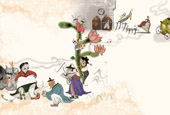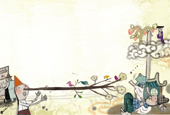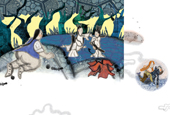View this article in another language
- 한국어
- English
- 日本語
- 中文
- العربية
- Español
- Français
- Deutsch
- Pусский
- Tiếng Việt
- Indonesian
“Byeol Ju Bu Jeon” is a Korean folktale from the 7th century. The story is recorded in Korea’s oldest existent history, published in the 12th century, and has been analyzed by Confucian scholars. The tale resembles Aesop’s fable “The Tortoise and the Hare” in that both tales feature a turtle and rabbit as the principal characters, but the setting, morals, and political implications of the stories are quite different.
As the story goes, the Dragon King, the king of the sea, was deathly ill. His subjects suggest that a hare’s liver could cure him, yet none of them are brave enough to venture onto land to get the liver— that is, until the turtle volunteers. Once ashore, the turtle finds a rabbit and persuades him to visit the underwater kingdom, where great riches, beauty, and honor—the turtle claims—await. The rabbit agrees.
Back underwater, in the audience of the Dragon King, the rabbit is restrained and regretfully informed that he must sacrifice his liver (and his life) to save the king. The rabbit cleverly tells them that he would be honored to help save the king’s life but has left his liver in the woods.
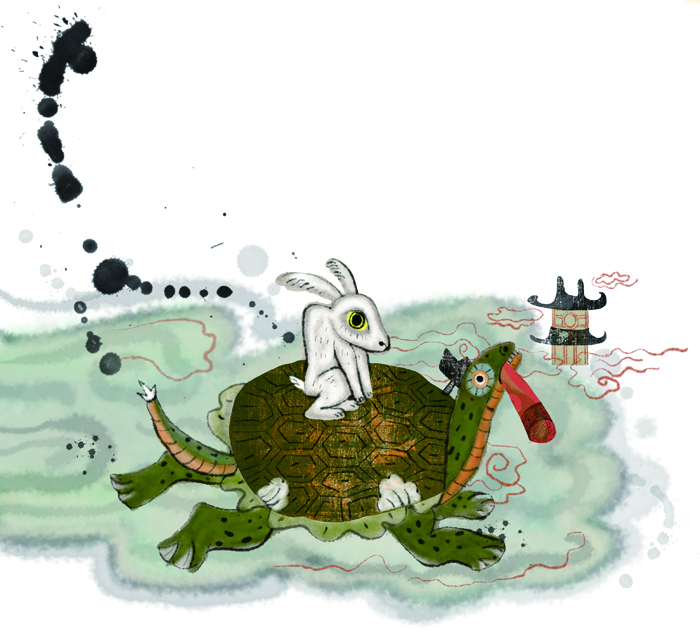 Rabbits, he tells the king, knowing the value of their livers, hide them aboveground in secret places. The hare says that he would be honored to retrieve it and give it over to the king if the king would send the turtle to escort him. The Dragon King is won over by this cavalier flattery and sends them back. Once on shore, the rabbit runs safely away from the turtle, telling him that they will never get his liver, that they were fools to believe him, and that the Dragon King will just have to die. Then he vanishes.
Rabbits, he tells the king, knowing the value of their livers, hide them aboveground in secret places. The hare says that he would be honored to retrieve it and give it over to the king if the king would send the turtle to escort him. The Dragon King is won over by this cavalier flattery and sends them back. Once on shore, the rabbit runs safely away from the turtle, telling him that they will never get his liver, that they were fools to believe him, and that the Dragon King will just have to die. Then he vanishes.
While the stories’ principal characters are obviously the same, they impart morals that are very different in substance and scope. In “The Tortoise and the Hare,” the moral of the story is twofold; first, do not be arrogant about your abilities, as the rabbit was, and second, hard work and determination trump natural talent.
The Korean story is just the opposite. The quick-thinking hare outsmarts the brave, loyal, and dim-witted turtle. The hare relies on his natural intelligence to win the day. Indeed, the rabbit is a symbol of cleverness in Korea. In this regard, “The Hare’s Liver” has much more in common with the African American folktales of Br’er Rabbit than “The Tortoise and the Hare.”
Both the Korean hare and Br’er Rabbit trick the powerful into letting them escape to their favored ground—the ground for the Korean hare and the briar patch in Br’er Rabbit’s case. The moral of “The Hare’s Liver” also extends beyond the scope of that of the fable—beyond the personal sphere and into the social one.
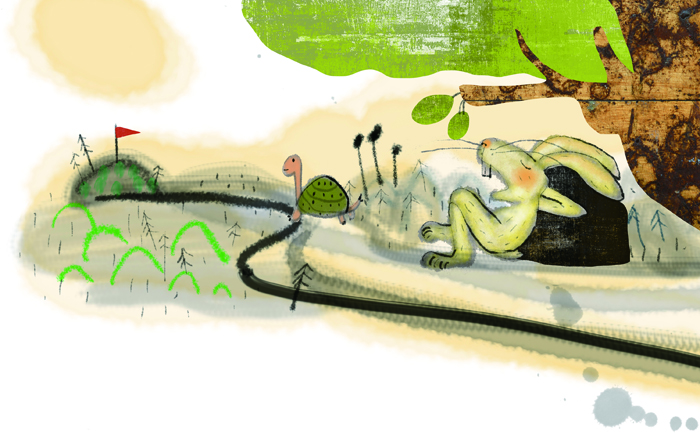 The Korean hare is symbolically associated with the peasant population, whereas the turtle, in the story, is associated with authority and royalty. Given these associations, “The Hare’s Liver” imparts a defense mechanism for the powerless: a social moral. That is, when wronged by the powerful, the weak should be sly and clever to escape unscathed.
The Korean hare is symbolically associated with the peasant population, whereas the turtle, in the story, is associated with authority and royalty. Given these associations, “The Hare’s Liver” imparts a defense mechanism for the powerless: a social moral. That is, when wronged by the powerful, the weak should be sly and clever to escape unscathed.
By the same token, there is also a social moral for the turtle: do not waste noble qualities with foolish action. Indeed, at the end of the tale, the tortoise is left with very little. His attributes go unheralded because the king is left to die and the rabbit has gone free.
Written by Charles Luskin
Illustrated by Shim Soo-keun
*The series of old Korean tales has been made possible with the cooperation with Korea Magazine.
As the story goes, the Dragon King, the king of the sea, was deathly ill. His subjects suggest that a hare’s liver could cure him, yet none of them are brave enough to venture onto land to get the liver— that is, until the turtle volunteers. Once ashore, the turtle finds a rabbit and persuades him to visit the underwater kingdom, where great riches, beauty, and honor—the turtle claims—await. The rabbit agrees.
Back underwater, in the audience of the Dragon King, the rabbit is restrained and regretfully informed that he must sacrifice his liver (and his life) to save the king. The rabbit cleverly tells them that he would be honored to help save the king’s life but has left his liver in the woods.

While the stories’ principal characters are obviously the same, they impart morals that are very different in substance and scope. In “The Tortoise and the Hare,” the moral of the story is twofold; first, do not be arrogant about your abilities, as the rabbit was, and second, hard work and determination trump natural talent.
The Korean story is just the opposite. The quick-thinking hare outsmarts the brave, loyal, and dim-witted turtle. The hare relies on his natural intelligence to win the day. Indeed, the rabbit is a symbol of cleverness in Korea. In this regard, “The Hare’s Liver” has much more in common with the African American folktales of Br’er Rabbit than “The Tortoise and the Hare.”
Both the Korean hare and Br’er Rabbit trick the powerful into letting them escape to their favored ground—the ground for the Korean hare and the briar patch in Br’er Rabbit’s case. The moral of “The Hare’s Liver” also extends beyond the scope of that of the fable—beyond the personal sphere and into the social one.

By the same token, there is also a social moral for the turtle: do not waste noble qualities with foolish action. Indeed, at the end of the tale, the tortoise is left with very little. His attributes go unheralded because the king is left to die and the rabbit has gone free.
Written by Charles Luskin
Illustrated by Shim Soo-keun
*The series of old Korean tales has been made possible with the cooperation with Korea Magazine.
